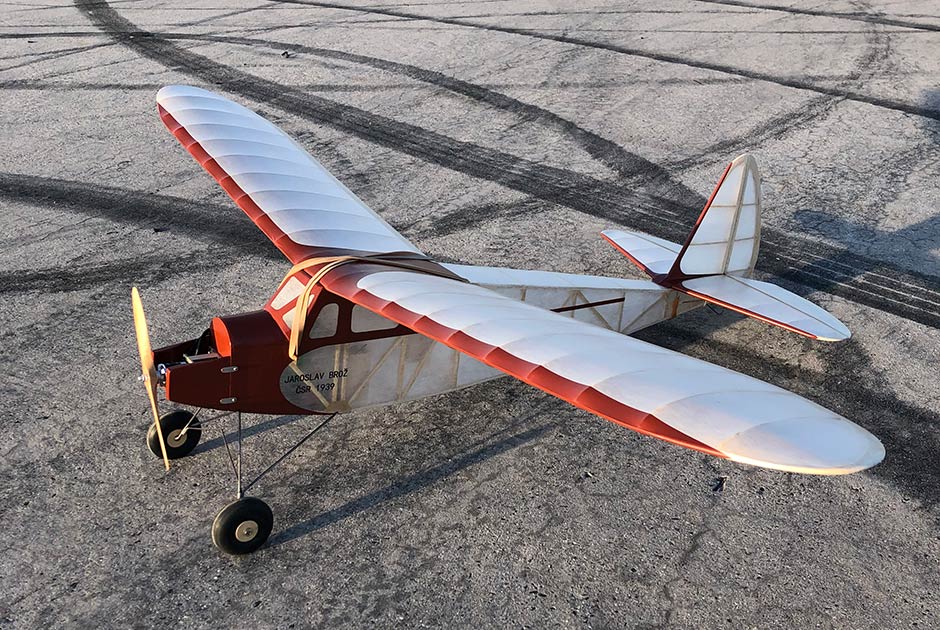I would like to start this post with a simple question. What do you usually do with models which you consider to be at the end of their “service”? Some modelers throw them into the trash or build the new again. Some of them burn crashed models or keep them displayed at their “hangars”. I tend not to throw any model away, no matter how old or “ruined” they really are. I want to use them as long as possible.
The most notable reason to retire any model after some time is the oil used to lubricate its engine. It literally does not matter how precise the model is protected against oil and fuel. After a couple of seasons, such model become soaked with oil, mostly there, where the engine is installed – from the first fuselage’s bulkhead (real planes use the word firewall) where the engine mount is located.

First signs of “being soaked” develop when the covering around the engine starts to peel off or slide spontaneously. This is the best time to give the model chance for a second life. The simplest way is to electrify it.
And here is my latest candidate for conversion. One of the oldest models I own in my hangar is Letná 56, designed by Jaroslav Brož back in 1939. Elegant construction was probably inspired by Paul Karnow`s model known as Quaker. To be fair, I have not built this model. It was given to me ten years ago sometime. And even that time, it was already far well flown – quite oily.
I have flown Letná 56 as it was, no changes were made except the engine. I have tried a wide range of engines from my collection including Baby Cyclone, Letná 6,3ccm, AL-KO 7,5ccm, Ohlsson&Rice .23, O.S. Max FS 26 and the last used was Forster .29. The last three in a row have intake oriented to the firewall and engine startup was not so easy. From my point of view, the most suitable engine for this model is Baby Cyclone, even the plan suggests going ahead with Letná 6,3ccm, which more or less is a nice Czech copy of the Baby Cyclone.

How to convert the pure gas-powered design into an electric-powered airplane? It is quite an easy task to perform today as there are “thousands” of combinations regarding motors, ESCs, and batteries available. So in theory we could say: “grab whatever you have and it will fly”. On the other hand, I prefer to maintain realistic behavior and as most as closer performance envelope as is provided by the petrol engine. Baby Cyclone has a peak power output of about 0,2HP at 5500RPM. In other words, the mechanical peak power output of the drive unit should be somewhere around 150W.
I used an online drive calculator to find the most suitable combination of motor, ESC, battery, and propeller. In the end, Dualsky ECO 2316C-1500 V2 motor was revealed to be the best balance between power and weight. Modern brushless motors are known for their excellent weight to power ratio, but most antique models need to be balanced with quite heavy engines. So even a smaller motor would do the same job well, I had to take its weight into account and choose another from a higher airplane category. Dualsky XC3012BA speed controller was then logically chosen as it is optimized to be used with this motor. The propeller is an ordinary antique 11x6in wooden NOS part produced by Carl Goldberg’s Top Flite company. And the battery is a lightweight 2cell LiPo 2200mAh 30C pack. This setup generates an electrical power peak of about 167W. The mechanical power output peaks 140W at full throttle, producing 918g of static thrust.

How does the converted Letná 56 fly? Very nice and stable and it can even land itself when properly balanced. Simply pretty close to the gas-powered version. The only difference is the lower p-factor generated by the propeller with a smaller diameter. Gliding characteristics remain the same.
After maiden flights, I have got an idea to attempt at any SAM CRC-Open/ELOT national contest. There are two interesting categories named ALOT and ELOT. Both are similar and differ by batteries and limited motor runtime/maximum reached altitude in case of an electric motor is used as a power unit. I have converted Letná 56 to be able to compete in both categories. There is an additional requirement to install an altimeter combined with a motor “kill switch” which is initiated after 30 seconds of runtime in ELOT and 90 seconds or 300 meters of altitude in ALOT respectively.
One of the best combinations of altimeter and kill switch available today is ALTIS produced by AEROBTEC. This is a small yet light device that is connected between the RC receiver and ESC. Altis stops the motor after a specific time has passed or when the desired altitude is reached, whatever occurs first.

Here is a short video from the training. As you can see, Letná 56 flies nicely, has plenty of power, but is neither under nor overpowered. It is as it should be and could of course be used as a recreational airplane too. In this case, the whole setup allows performing 20+ minutes duration flights. One tip in the end. Letná 56 and this should apply to other models too glides better when the motor brake is enabled. A stopped wooden propeller generates less aerodynamical drag than milling (freely turning) propeller.

Leave a Reply